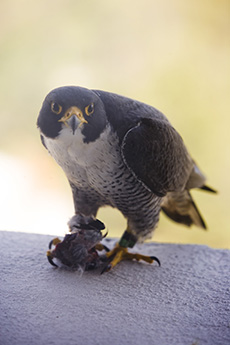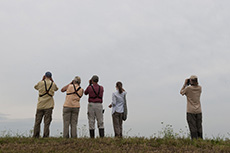Climate affects number of birds seen at Fermilab
 |
A peregrine falcon stands on a ledge on Wilson Hall's 15th floor. While changes in climate have caused a decline in on other types of birds at Fermilab, certain predatory birds like this falcon have seen an uptick. Photo: Reidar Hahn
|
According to the Fermilab Bird List, the lab is a haven for more than 200 bird species. But changes in climate have led to the decline of some species in recent years, bird monitors say.
Peter Kasper, Fermilab physicist, member of the bird counting club and author of the Birds of Fermilab website, began the practice of surveying birds in 1987. His system comprises annual Christmas and spring bird counts as well as surveys of species seen over eight-day periods. The data is divided into five-year periods that are charted online.
For an inland site, Fermilab is propitious for birds, Kasper said, since its grasslands and bodies of water provide a suitably diverse habitat.
Kasper describes local changes in climate as having a dramatic effect on the bird population at Fermilab, especially among waterfowl. He says birds such as ducks and geese time their migration with the availability of food and water, which are weather-dependent. When warmer temperatures linger longer, birds head south later in the year. Fermilab's data also show them coming back sooner.
Some species don't come back at all.
"We have seen plummeting numbers of birds, especially warblers, in the spring and fall," said Dave Spleha, a local community member that helps monitor the lab's bird population and run the Birds of Fermilab website.
There is a very narrow gap in which migratory birds can breed, especially shorebirds that breed in the arctic tundra.
"So they need to get to their breeding site as fast as possible when the weather breaks," Spleha said. "If they are delayed even a little bit, it ultimately affects their population."
Spleha added that another reason they are seeing lower numbers at Fermilab could be a reflection of global habitat losses: Warblers make their summer homes in the northern boreal forests and spend winters in tropical rainforests, both of which have seen declines. Even though Fermilab has actually improved its habitability over the years, the bird populations disturbed by these losses may not survive to return here.
These apparent trends do not bode well for biodiversity, Kasper explained. The presence of a wide variety of species is a vital part of a healthy, flourishing ecosystem.
"Where I used to be able to spot as many as 20 species in one day, I'll now only see 10 on a good day," Kasper said.
And of those species, it is common now to only come across one or two, Spleha added.
All is not doom and gloom, though. Several predatory birds, such as Cooper's hawks, bald eagles, peregrine falcons and ospreys, seem to be making a comeback at Fermilab. This is likely due in part to the fact that eagles are protected by federal law and that the latter two birds are on Illinois' endangered and threatened species list.
—Sarah Witman
 |
Several birdwatchers, led by Fermilab physicist and bird enthusiast Peter Kasper, scan the skies for signs of various bird species at a bird-watching event in 2010. Photo: Reidar Hahn
|
|